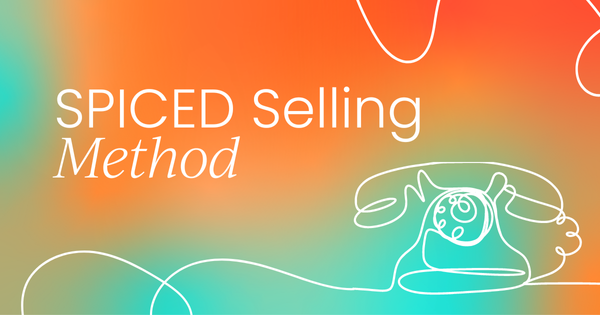What is the SPICED sales methodology?
The SPICED sales methodology is a collection of five conversational elements developed by Winning by Design that act as a roadmap for your selling process. The SPICED selling method’s five elements are designed to help salespeople identify customer needs, and position their product or service as the solution to those needs.
This selling method aims to help sellers diagnose the problem a buyer has, develop a deep understanding of the viability of this deal in particular, and finally to demonstrate understanding, and empathy for, that problem to maximize persuasiveness.
Since it focuses on customer pain points, the SPICED sales method is a customer-centric sales approach that overlaps with solutions-based selling and needs-based selling.

What are the five steps of the SPICED sales framework?
SPICED stands for:
- Situation
- Pain
- Impact
- Critical Event
- Decision
These are the five elements of the SPICED framework, and each acts as a conversational milestone, or talking point, for the seller to focus on at different stages of the customer interaction.
If you're familiar with the SPIN sales methodology, you'll notice the similarities immediately.
Each of the five steps facilitates information gathering about a different critical aspect of the selling process. In its simplest form, you can think of it like a checklist to work through, making sure you’ve got adequate information on all of these topics, each of which is critical to the sale.
To close the deal, reps need to understand:
- The buyer’s situation,
- The pain they’re feeling,
- The impact you can have on their business,
- The critical event that acts as a deadline for the deal,
- And how the buying decision will be made.
Let’s examine each of these five steps in more detail.
1) Situation
The situational stage of the SPICED methodology occurs when a seller first begins building a direct relationship with the buyer, at the beginning of a discovery call.
In this stage, reps should try to get the prospect talking about:
- Their organization.
- The competitive landscape they’re a part of.
- Their market positioning.
- Industry trends.
- Recent business developments.
- The tools in their tech stack, their strengths, and their shortcomings.
A sales rep’s goal through all of this is, again, to gather information about the buyer’s general situation.
• At this stage, questions can be very general. The aim is just to get the prospect talking about how they do things right now.
• Always think ahead to the later steps in the SPICED method. If you hear emotional language, for example, consider this a verbal cue that you’re ready to move the conversation to the pain stage.
2) Pain
While listening to the prospect talk about their situation, reps should be listening out for possible pain points: problems or frustrations the prospect is experiencing with their current situation. These are the focus of the second stage of the SPICED process, and are often the things that bring prospects to you.
Usually, these challenges and frustrations relate to the failure of existing solutions or processes. As you probe for details with your situational questions, you’ll want to listen out for such failures. Unmet expectations and underperforming solutions are your way in.
For example, if you’re selling project management software, you might find one prospect does all their project management in an Excel spreadsheet. You can imagine some of their frustration. As you’re listening, you might notice clues that they’re frustrated with the unintuitive user experience, and a lack of functionality.
• Listen for emotional language around things the prospect is trying to achieve.
• Hopes and desires for the future can be just as important clues as negative emotional language.
• Ask prospects questions like, “What would that process look like in an ideal world?”.
• The stronger a buyer’s emotional pain, the more interested they’ll be when you offer a solution.
• Consider how appropriate your solution is for the particular problems the customer is having. How much of an antidote to their pain can your product be?
3) Impact
This stage is all about uncovering details about the impact adopting your product could have on the prospect and their org.
If you can express the prospect’s frustrations back to them, but not tie them to shortcomings in their existing solution, you’ll struggle to position your own product as an essential addition to their tool set.
Details are the key.
Just as, in the Situation stage, reps should listen for emotional language to help them transition into the Pain stage, reps should listen out for specific details about where those frustrations come from.
Details are the bridge between the Pain and Impact stages of the SPICED methodology. You want to get really good at expressing back to the prospect exactly where their existing solution is falling short. This will not only show your buyers you understand their pain, but also set you up to position your product as the answer they’ve been looking for.
• Remember: details are key. If you’re able to articulate the prospect’s frustrations, but not how your product could help them, you might be lacking in specifics.
• Get the customer to give you details about how their existing solution falls short of their ideal outcome.
• Ask questions that drill down into the details of where and how current solutions are failing.
• Keep the conversation focused on the prospect; their situation, their emotional state, the impact to them and their everyday life, as well as the longer-term impact to their organization.
• Emphasize the downsides, and risks involved, with not taking action, too, to further persuade action.

4) Critical event
In the SPICED sales methodology, the critical event is the deadline your prospect needs to have the deal done by.
Or, that they need to show evidence of progress by a particularly critical meeting, and that getting a solution in place that enables such reporting before then is necessary. During the critical event stage, you’ll ask the prospect questions about their deadlines.
It’s still just as important to gather as much information as possible during this stage. A single date isn’t enough. You want to understand why this date is important to the buyer, what the consequences for missing that date might be, and any other dates that might impact the sale.
• Don’t confuse the prospect’s critical event with your own mental deadline of when you want the deal done. Wanting to close the deal before the end of the quarter so you can hit quota is not a critical event.
• Be wary of false deadlines. When your buyer mentions a date, test it by asking what the consequences will be if that deadline isn’t met.
• If there are few, or no, consequences for missing the deadline, this is probably not the key deadline you’re looking for.
5) Decision
In the final stage of the SPICED process, you’ll seek to uncover information about the decision-making process at your buyer’s firm.
Key information includes:
- Who’s involved in the process?
- Are decisions made by committee, or does an individual have the final say?
- What are their criteria for making a decision?
- How long does the process typically take?
Remember, you won’t always be speaking to the ultimate decision maker. Even if you’re able to convince the person you’re speaking to that you can help them, you’re not guaranteed to get a sale unless the ultimate decision-maker gives their sign-off.
Balancing persuasive energy between the needs of the person they’re talking to, and the needs of the ultimate decision maker, is one of the biggest challenges your sales team can face. Spending enough time during the discovery stage figuring out the ultimate impact is an effective method of handling this, since you’ll be able to position your product as the solution to the issues the wider organization is facing.
• Prioritize prospects based on the probability they’re a winnable client.
• Ask about the firm’s previous experiences bringing products similar to yours into their working processes.
• Expertly anticipating objections and requirements from an entire decision-making committee is a difficult sales skill to master. The more information you can uncover during the other SPICED stages, the easier a time you’ll have here.
Example of the SPICED method
Let’s say you’re selling a SaaS project management solution for large, mature enterprises, and you’re in conversation with a prospect.
Here’s a brief look, in Q&A format, into what a conversation following the SPICED selling methodology might look like.
The “Situation” stage
Q: “How many staff members do you employ globally?”
A: “Around 600 staff members globally.”
A question early on about the size of the business gives you a sense of what’s at stake. As with all work, it pays to prioritize. In sales, that’s no different, and uncovering information (like the size of the account you could win) helps you do just that.
It also provides much-needed context for what you’ll learn later in the process.
The “Pain” stage
Q: “What challenges are you facing around internal organization?”
A: “Missed deadlines, lost tasks, lack of accountability. Lack of visibility into ownership.”
The pain stage is critical, so questions about challenges and frustrations are a no-brainer here.
Remember to watch out for emotional language. If the prospect is hesitant to talk about negatives, ask them instead what their processes would look like in an ideal world, or about the consequences of existing processes failing.
The “Impact” stage
Q: “How do missed deadlines and lack of ownership affect productivity, morale, and revenue growth at your company?”
A: “Productivity and morale are definitely hurt by it, with knock-on effects to our rate of revenue growth.”
Questions about the impact failing solutions are having gives you a sense of the impact your own products could have, and enables you and the rest of your sales team to position your solution as the answer to the prospect’s prayers.
The “Critical event” stage
Q: “When do you need a working solution for project management by? What happens if you miss this deadline?”
A: “Leadership team wants a working, viable, and scalable solution for project management in place by end of quarter.”
When you know that this is a quality lead that’s a good fit for your product, and that your solution could really positively impact their org, it’s time to start gathering information about the deal itself.
Direct questions about the timeline your buyer is working towards are important, as they give you the clearest sense of how fast you need to move, and what information to provide.
The “Decision” stage
Q: “Who is involved in the decision-making process? What are your criteria for making a decision around adopting a new tool like this?”
A: “The CFO gets final sign-off on any new tools for budgetary reasons. Price, integration with other tools, and API-access for powerful reporting are all high priority decision criteria.”
Information you gather at the Decision stage is all-important. This is where you learn who else you have to persuade (often without direct access to them), how fast or slow the deal might move, and exactly which criteria you need to speak to when positioning your product to stand the best possible chance of winning the deal.
5 Tips for using the SPICED selling method to close more deals
1) Ask open-ended questions
Remember that the aim of this sales methodology is to gather information in a structured way.
Closed-ended questions shut this down. Open-ended questions, meanwhile, force long form, unique answers from prospects that will reveal information helpful to moving the customer through the sales cycle.
Ask open-ended questions while moving through the SPICED framework to gather as much information as possible.
2) Demonstrate active listening
In his groundbreaking book on negotiation, Never Split the Difference, former FBI hostage negotiator Chris Voss introduces the concept of Mirroring. This is where, while gathering information, you repeat back to a person the last few words of what they just said.
This is a great way to listen actively, since it’s a foolproof way of communicating to your prospect that you’re in sync with them, while prompting them to continue. It’s also a great way of stalling for time if you’re not quite sure how to respond to what they’ve just said, since it puts the onus back on them to continue speaking.

While Voss’s mirroring technique is very effective, the best way to demonstrate active listening is to repeat back to someone what they’ve said in your own words, rather than in words they’ve used.
This reflects an age-old principle described by Stephen R. Covey in 7 Habits of Highly Effective People: “Seek first to understand, then to be understood.” When you’re able to signal to someone that you understand them, and perhaps even communicate their problems to them more clearly than they can articular them to themselves, they feel you’re on their side. If you’re on-side, you’re trustworthy, and they’re much more likely to listen to what you have to say.
3) Consider the decision-making committee
Always be thinking about the committee behind the decision-making process.
While Decision is the final stage in the SPICED methodology, you need to bear it in mind from the start.
The more in-tune you are with the fact the person on the other end of the phone isn’t the only one you have to persuade, the better your chances of closing the deal.
You’ll be more aware of the decision-making criteria you should be speaking to and, therefore, how you should be positioning your product. It’ll also help direct the questions you ask at each stage of the discovery process.
4) Use the framework as structure for enablement content
Frameworks like SPICED exist to help your salespeople close more deals. They provide structure to the sales cycle, and the conversations taking place within it, through the discovery stage and beyond.
If your org has a sales enablement function, and favors the SPICED sales method, your enablement team can build their enablement content around the five stages of the SPICED structure.
Competitive battlecards offer structure to a sales call in the same way SPICED does. They’ll lead with an overview of a particular competitor, but the best will go on to offer ways to handle common objections, offer so-called landmine questions that lead the prospect to reveal to themselves why a competitor’s solution might not be viable, and even include information about a competitor’s strengths and their pricing strategy.
In a similar way, enablement reps can develop SPICED cheatsheets as a part of their enablement content, driving faster onboarding for new reps, and improving the Time to Productivity metric.
5) Work with sales enablement for even better results
If you’re struggling to increase your win rates, having a few reps adopt a new sales methodology might not be enough.
If you don’t already have one, a dedicated sales enablement professional can help enable your reps with the information they need at every stage of the sales process to persuade customers, handle objections, ward off would-be competitors, and seal the deal once and for all.


Sales enablement insider
Thank you for subscribing
Level up your sales enablement career & network with sales enablement experts
An email has been successfully sent to confirm your subscription.
 Follow us on LinkedIn
Follow us on LinkedIn


.png)


